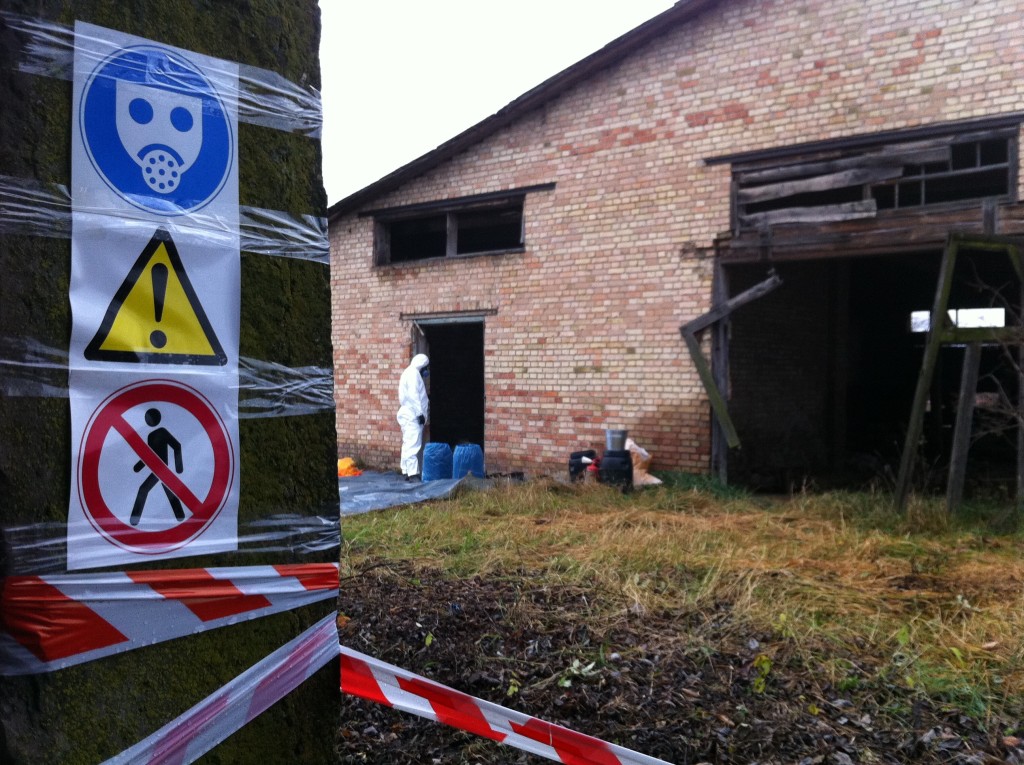Scattered across the former Soviet republics of Ukraine, Moldova, Armenia and numerous other countries like i.e. Slovakia, Poland, Macedonia and Rumania lays around 300.000 tonnes of obsolete pesticides and other highly dangerous and even deadly chemicals.

They are the sins of the past.
According to the “Stockholm convention” from 2004, the chemicals are amongst what is known as “The Dirty Dozen” and it contains some of the most toxic and hazardous substances the world has ever seen.
Many of the dumpsites are totally unprotected – anyone can literally walk straight in and take what they like. Some of the chemicals, (i.e. HCB, DDT, Lindane and Aldrin), can therefore easily be used by terrorists and/or other criminals for – in what is described as “dirty bombs”.
A few buckets can easily destroy the drinking water for hundreds of thousands of citizens in the former Soviet republics. And the toxic waste is a ticking time bomb when it comes to the quality of many European rivers and marine areas like the Baltic Sea, The Black Sea etc.
But hardly anyone – or only a few – is actually doing something about the problem that threatens the life quality for human beings and the surrounding environment.
The FAO/UNEP have, however recently initiated a tender for cleaning up some of the worst places, but it is – sadly enough – far from solving the problem.
One obstacle is to identify who dumped the waste and what it actually contains.
The other is to raise the money to clean it up. Some of the companies who are able to remove and ensure that the obsolete pesticide will be destroyed in a safe way are aimed to start their work in 2015. With a small budget from the UN and EU it will – to be positive – be a start.
But more realistic it’s best described as “a drop in the ocean”. Much more needs to be done.
Billion of Euro’s
In Western Europe, we have been hit by scandals and incidents where these dangerous pesticides – known as the “Dirty Dozen” – have entered the food chain. It happened in Germany in 2001 were all food export was blocked. Later Germany determined the cost of 500 million Euro due to cleaning up the mess and the estimated costs of the export ban.. And that’s the price for a single location – and there are 10,000 others.
The solution to this problem is not so difficult or expensive. It costs around one billion Euro. The cost is app. 3.000 euro per tons. And the problems must be solved by the EU. We have the technology, and we have money. If we wait, it becomes much more expensive …. Worst case scenario is 10,000 x 500 million Euro.
The dirty bomb
A small amount of this highly concentrate chemicals is enough to kill all the citizen of a city with the size of Copenhagen or Oslo. That’s why we – more than 20 years ago – solved the problem in Western Europe. In future years the pesticides will hit the ground water. It already has huge effects on the environmental and the food chain. This is a part of Europe that we don’t want to know about, it is a forgotten story and it affects millions of citizen in Eastern Europe.
However, Western Europe will learn more about it; like it or not.
John Vijgen has been working with the problem for more than 20 years, both as an Engineer – working for a Dutch company which destroyed the obsolete pesticides in Holland and West Germany, but stopped working on the issue as there was no money for that kind of work in Eastern Europe.
John Vijgen – who is behind the ngo: www.ihpa.info explains our contaminated future:
“This pesticide-bomb will hit the West in the face sooner or later. It’s only a matter of time when the poison reaches the drinking water there and enters our food chain here. Or it’s the other scenario, when terrorist lay their hands on these easiest ingredients for biotech weapons.”
The obsolete pesticides are chemicals supposed to be used in the agricultural production in the past. They where produced in the Soviet Union and spread all over Eastern Europe. With the collapse of the Soviet Union, the centralized agricultural system also disappeared and local farmers didn’t know what to do with the storage of the pesticides. But they are extremely hazardous even if they cannot be used anymore; they are laying on the ground, are buried or placed in ramshackle storages. In many places anyone can enter the dumpsites.